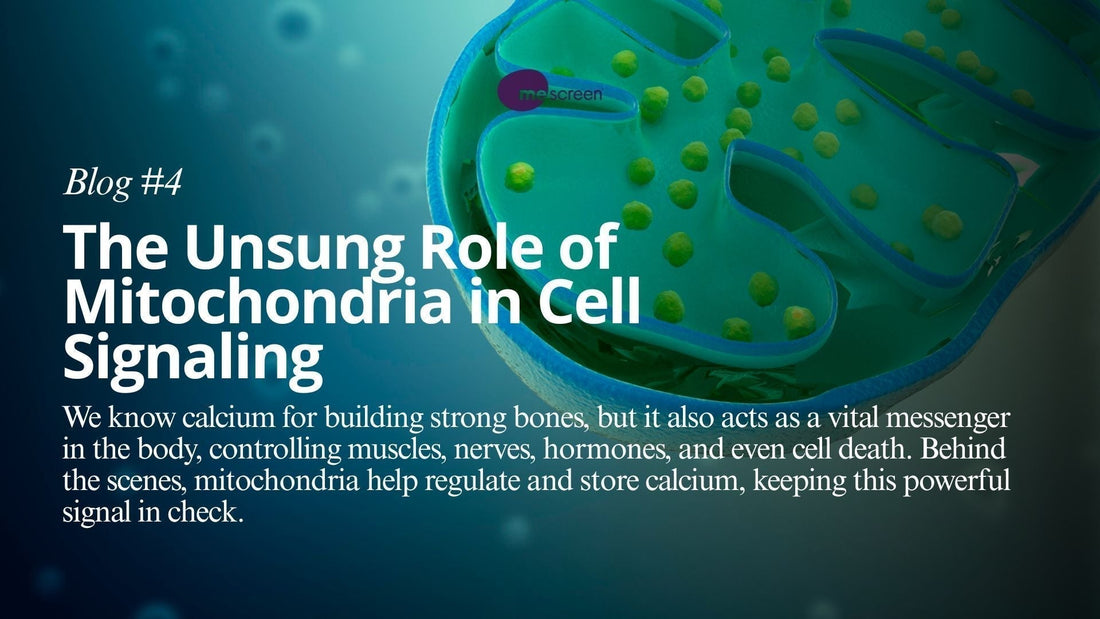⚡ They Manage Calcium Levels: The Unsung Role of Mitochondria in Cell Signaling
When you think of calcium, your mind probably jumps to strong bones and teeth — and that's not wrong. But calcium's role in your body goes far beyond your skeleton. In fact, calcium ions are one of the most important cellular messengers in the human body.
From muscle contractions to nerve impulses, hormone release, and even cell death, calcium is the silent signal that keeps things running. But what keeps calcium itself in check?
The answer lies inside your cells, in the mitochondria. While best known for their role in energy production, mitochondria are also deeply involved in calcium storage, buffering, and signaling. Let's dive into how these tiny organelles manage one of your body's most critical messengers.
🔬 Why Calcium Matters Beyond Bones
Calcium ions (Ca²⁺) are used in:
- 🧠 Nerve communication — transmitting electrical impulses between neurons
- 💪 Muscle contraction — triggering actin and myosin to slide and shorten muscle fibers
- 💉 Hormone release — allowing cells to send chemical signals into the bloodstream
- 🧬 Gene expression — turning certain genes on or off in response to signals
- ☠️ Cell death (apoptosis) — helping decide when damaged cells should be removed
Calcium is constantly flowing in and out of cells and organelles, but only in precise amounts. Too much or too little calcium in the wrong place, at the wrong time, can lead to serious dysfunction or disease. This is where mitochondria come in.
🧭 Mitochondria: Calcium Gatekeepers
Mitochondria don't just float around making ATP, they also act as calcium buffers. They take in calcium when levels are too high in the cytosol (the fluid inside cells) and release it when needed to support cell activity.
Here's how it works:
- Calcium enters the cell through ion channels on the plasma membrane.
- The endoplasmic reticulum (ER) stores calcium and releases it in bursts during signaling.
- When these calcium levels spike, mitochondria rapidly absorb calcium through a protein called the Mitochondrial Calcium Uniporter (MCU).
- Mitochondria store calcium in their matrix or release it later to regulate energy production or trigger signaling pathways.
- Once the signal is complete, mitochondria help return calcium to normal levels, protecting the cell from overload.
This calcium buffering function helps prevent damage and ensures proper communication between cells and organelles.
Mitochondrial calcium regulation diagram
⚙️ Why Mitochondrial Calcium Regulation Is Crucial
When mitochondria handle calcium properly, everything works smoothly. But if this system breaks down?
- Too much mitochondrial calcium → can trigger cell death via apoptosis
- Too little mitochondrial calcium → leads to poor ATP production and low energy
-
Chronic imbalance → has been linked to conditions like:
- Alzheimer's disease 🧠
- Parkinson's disease 🧬
- Heart failure ❤️
- Muscle weakness or fatigue 💪
- Hormonal imbalances and infertility
That's why mitochondrial health and calcium handling are central to your metabolic health, cellular communication, and longevity.
🔋 Mitochondria Use Calcium to Make Energy
One of the most fascinating connections? Calcium directly influences mitochondrial energy production.
When mitochondria absorb calcium, they activate key enzymes in the Krebs cycle (the core of cellular respiration). This ramps up ATP synthesis, meaning calcium actually boosts your cell's ability to make energy, when managed correctly.
It's a brilliant feedback loop:
✅ More activity = more calcium = more ATP
❌ Too much calcium = risk of burnout or damage
🧪 Measuring Your Mitochondrial Health
If you're dealing with symptoms like fatigue, muscle weakness, brain fog, or hormonal shifts, it could be linked to impaired mitochondrial calcium handling.
Tools like mescreen™ allow you to assess:
- Your mitochondrial efficiency and stress levels
- How well your cells manage energy and intracellular signaling
- Early signs of metabolic dysfunction
With that insight, you can make targeted changes in your diet, movement, and lifestyle to restore balance and energy at the cellular level.
mescreen™ testing visualization
🌟 Final Thought: Tiny Messengers, Massive Impact
Calcium might not get as much attention as carbs, fats, or even electrolytes, but it's arguably more critical, especially when it comes to communication inside your body.
And mitochondria? They're the ones making sure those messages are delivered, managed, and responded to with precision.
By taking care of your mitochondria, you're not just powering your body, you're refining its internal language.
References
-
Baughman, J. M., et al. (2011).
"Integrative genomics identifies MCU as an essential component of the mitochondrial calcium uniporter." Nature, 476(7360), 341–345.
https://doi.org/10.1038/nature10234 -
Rizzuto, R., De Stefani, D., Raffaello, A., & Mammucari, C. (2012).
"Mitochondria as sensors and regulators of calcium signalling." Nature Reviews Molecular Cell Biology, 13(9), 566–578.
https://doi.org/10.1038/nrm3412 -
Giorgi, C., Marchi, S., & Pinton, P. (2018).
"The machineries, regulation and cellular functions of mitochondrial calcium." Nature Reviews Molecular Cell Biology, 19(11), 713–730.
https://doi.org/10.1038/s41580-018-0052-8 -
Szabadkai, G., et al. (2006).
"Chaperone-mediated coupling of endoplasmic reticulum and mitochondrial Ca2+ channels." Journal of Cell Biology, 175(6), 901–911.
https://doi.org/10.1083/jcb.200608073 -
Rueda, C. B., et al. (2014).
"Mitochondrial calcium uptake and its role in health and disease." Biochimica et Biophysica Acta (BBA) - Molecular Cell Research, 1837(9), 1254–1261.
https://doi.org/10.1016/j.bbabio.2014.03.011 -
National Institutes of Health (NIH): MedlinePlus Genetics
"Mitochondria."
https://medlineplus.gov/genetics/understanding/cellfunction/mitochondria/

